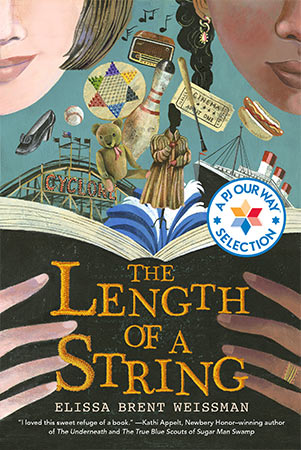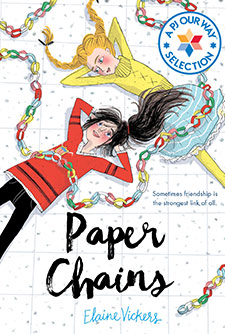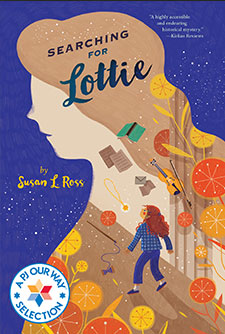The Length of a String
As the only Black girl at Hebrew school, Imani’s less than curious about her adoptive family’s Jewish history, and more than a little curious about her own. How can she find out about her birth family without hurting her mom’s feelings?
Average Rating
( hint: Login to leave a review! )
98 Reviews
Leave Review
What the Book is About
Jewish Content & Values
Positive Role Models
Content Advisory
Talk it Over!
More for You
What the Book is About
Not only is Imani the only Black girl in Hebrew school, but she’s also required to study a heritage that she’s got no biological connection to. She really wants to research where she comes from, but she’s afraid of offending her adoptive parents. When she inherits her mom’s grandmother Anna’s diary, she soon discovers that her adoptive family history is so much more relevant than she could have predicted. This sensitive and beautifully written coming-of-age novel will keep kids hooked until the very end.
Jewish Content & Values
- At Hebrew School at their synagogue, Parker, Madeline, and Imani prepare for their b’nai mitzvah by writing speeches, learning to read from the Torah, and researching an aspect of the Holocaust.
- Imani’s adoptive great-grandmother Anna is a Holocaust survivor from Luxembourg. When she dies, the family sits shiva and recites the Mourner’s Kaddish.
- Imani’s Hebrew name, Emunah, means faith, and Madeline is named for her great aunt Mildred in accordance with the Ashkenazi naming traditions.
- Grandmother Anna’s American family kept Orthodox Jewish traditions, such as observing Shabbat, although her aunt often broke the rules when her uncles were not around.
Positive Role Models
- Imani really wants to find out about her biological family history, yet she is sensitive to her adoptive parents’ feelings.
- Madeline is a loyal best friend and her friendship supports Imani throughout the book.
Content Advisory
- Grandmother Anna left Luxembourg at age 12, leaving her entire family behind. There’s very general, age-appropriate description of the fate of Jewish families during the Holocaust, and many of the characters written about in the diary do not survive.
- Grandma Anna’s American family were furriers, and there are several passages that describe the glamour and beauty of wearing a fur coat, as well as reference to current antifur sensibilities.
- Imani and her friends talk about her liking Ethan, and in a quick, happy scene on the way to their friend Parker’s bat mitzvah, she kisses him.
Talk it Over!
On the bus to her bat mitzvah, some of Parker’s camp friends ask Imani how she can be Black and Jewish. If you were Imani, how would you feel to be asked such a question? How would you respond?
More for You
Congregation Ramath Orah was founded in NYC in 1942 by Luxembourg Rabbi Dr. Robert Serebrenik and his wife, Julia, along with sixty-one Jewish refugees, also from Luxembourg. Rabbi Serebrenik was appointed chief Rabbi of Luxembourg in 1929 at the age of 28 and worked tirelessly to save the Jews of his country from the Nazis. He managed to organize clandestine escapes for over half the population: 2,000 Jews emigrated from Luxembourg by the time the Nazis invaded in 1941. Today, this thriving, inclusive Orthodox congregation, located near Columbia University, is home to a diverse community and recently celebrated its 75th anniversary.
What the Book is About
What the Book is About
Not only is Imani the only Black girl in Hebrew school, but she’s also required to study a heritage that she’s got no biological connection to. She really wants to research where she comes from, but she’s afraid of offending her adoptive parents. When she inherits her mom’s grandmother Anna’s diary, she soon discovers that her adoptive family history is so much more relevant than she could have predicted. This sensitive and beautifully written coming-of-age novel will keep kids hooked until the very end.
Jewish Content & Values
Jewish Content & Values
- At Hebrew School at their synagogue, Parker, Madeline, and Imani prepare for their b’nai mitzvah by writing speeches, learning to read from the Torah, and researching an aspect of the Holocaust.
- Imani’s adoptive great-grandmother Anna is a Holocaust survivor from Luxembourg. When she dies, the family sits shiva and recites the Mourner’s Kaddish.
- Imani’s Hebrew name, Emunah, means faith, and Madeline is named for her great aunt Mildred in accordance with the Ashkenazi naming traditions.
- Grandmother Anna’s American family kept Orthodox Jewish traditions, such as observing Shabbat, although her aunt often broke the rules when her uncles were not around.
Positive Role Models
Positive Role Models
- Imani really wants to find out about her biological family history, yet she is sensitive to her adoptive parents’ feelings.
- Madeline is a loyal best friend and her friendship supports Imani throughout the book.
Content Advisory
Content Advisory
- Grandmother Anna left Luxembourg at age 12, leaving her entire family behind. There’s very general, age-appropriate description of the fate of Jewish families during the Holocaust, and many of the characters written about in the diary do not survive.
- Grandma Anna’s American family were furriers, and there are several passages that describe the glamour and beauty of wearing a fur coat, as well as reference to current antifur sensibilities.
- Imani and her friends talk about her liking Ethan, and in a quick, happy scene on the way to their friend Parker’s bat mitzvah, she kisses him.
Talk it Over!
Talk it Over!
On the bus to her bat mitzvah, some of Parker’s camp friends ask Imani how she can be Black and Jewish. If you were Imani, how would you feel to be asked such a question? How would you respond?
More for You
More for You
Congregation Ramath Orah was founded in NYC in 1942 by Luxembourg Rabbi Dr. Robert Serebrenik and his wife, Julia, along with sixty-one Jewish refugees, also from Luxembourg. Rabbi Serebrenik was appointed chief Rabbi of Luxembourg in 1929 at the age of 28 and worked tirelessly to save the Jews of his country from the Nazis. He managed to organize clandestine escapes for over half the population: 2,000 Jews emigrated from Luxembourg by the time the Nazis invaded in 1941. Today, this thriving, inclusive Orthodox congregation, located near Columbia University, is home to a diverse community and recently celebrated its 75th anniversary.




